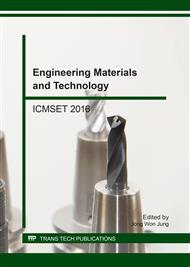[1]
F. D. Elia, C. Ravindran, Influence of grain refinement on hot tearing in B206 and A319 aluminum alloys, Trans. Indian Inst. Met. 62 (2009) 315–319.
DOI: 10.1007/s12666-009-0072-3
Google Scholar
[2]
H. K. Kamga, D. Larouche, M. Bournane, A. Rahem, Hot tearing of aluminum – copper B206 alloys with iron and silicon additions, Mater. Sci. Eng. A. 527 (2010) 7413–7423.
DOI: 10.1016/j.msea.2010.08.025
Google Scholar
[3]
J. Song, Z. Wang, Y. Huang, A. Srinivasan, F. Beckmann, K. U. Kainer, et al. , Hot tearing characteristics of Mg–2Ca–xZn alloys, J. Mater. Sci. 51 (2016) 2687–2704.
DOI: 10.1007/s10853-015-9583-y
Google Scholar
[4]
A. K. Birru, D. B. Karunakar, M. M. Mahapatra, A study on hot tearing susceptibility of Al-Cu, Al-Mg, and Al-Zn alloys, Trans. Indian Inst. Met. 65 (2012) 97–105.
DOI: 10.1007/s12666-011-0112-7
Google Scholar
[5]
A. Dissertation, Hot Tearing in Cast Aluminum Alloys : by, (2010).
Google Scholar
[6]
A. Amerioon, M. Emamy, G. Ashuri, Investigation the Effect of Al-5Ti-1B Grain Refiner and T6 Heat Treatment on Tensile Properties of Al-8 % Mg, 11 (2015) 32–37.
DOI: 10.1016/j.mspro.2015.11.039
Google Scholar
[7]
E. Aguirre-De La Torre, U. Afeltra, C. D. Gómez-Esparza, J. Camarillo-Cisneros, R. Pérez-Bustamante, R. Martínez-Sánchez, Grain refiner effect on the microstructure and mechanical properties of the A356 automotive wheels, J. Mater. Eng. Perform. 23 (2014).
DOI: 10.1007/s11665-013-0596-x
Google Scholar
[8]
K. R. Cardoso, D. N. Travessa, A. G. Escorial, M. Lieblich, Effect of mechanical alloying and Ti addition on solution and ageing treatment of an AA7050 aluminium alloy, Mater. Res. 10 (2007) 199–203.
DOI: 10.1590/s1516-14392007000200017
Google Scholar
[9]
W. Ding, T. Xia, W. Zhao, Y. Xu, Effect of Al-5Ti-C master alloy on the microstructure and mechanical properties of hypereutectic Al-20%Si alloy, Materials (Basel). 7 (2014) 1188–1200.
DOI: 10.3390/ma7021188
Google Scholar
[10]
A. B. Pattnaik, S. Das, B. B. Jha, N. Prasanth, Effect of Al-5Ti-1B grain refiner on the microstructure, mechanical properties and acoustic emission characteristics of Al5052 aluminium alloy, J. Mater. Res. Technol. 4 (2014) 171–179.
DOI: 10.1016/j.jmrt.2014.10.017
Google Scholar
[11]
K. Venkateswarlu, S. K. Das, M. Chakraborty, B. S. Murty, Influence of thermo-mechanical treatment of Al Á 5Ti master alloy on its grain refining performance on aluminium, Mater. Sci. Eng. A. 351 (2003) 237–243.
DOI: 10.1016/s0921-5093(02)00842-0
Google Scholar
[12]
K. Venkateswarlu, B. S. Murty, M. Chakraborty, Effect of hot rolling and heat treatment of Al – 5Ti – 1B master alloy on the grain refining efficiency of aluminium, 301 (2001) 180–186.
DOI: 10.1016/s0921-5093(00)01422-2
Google Scholar


